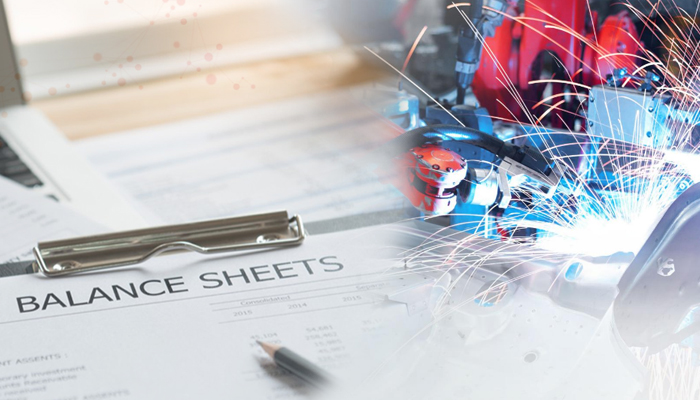
1000+
customers

50+ countries
across the world

Outsourcing leader
since 2008

Technology-driven
services

Stringent
quality processes
What all Must be Included in the Balance Sheet of a Manufacturing Company?
Last updated: 28 Jul, 2023 By Ashish Rana | 6 Minutes Read

What is a Balance Sheet?
The balance sheet of manufacturing company comprises the number of assets it owns, along with the capital and liabilities, equity of the owners, etc., at a given point of time, which is generally the year or month-end. In short, the balance sheet shows the owners and the external parties what the company owns and owes.
The name balance sheet reflects the nature of the accounting equation that balances the assets with the owner’s equity and liabilities. It is the core aspect of managing accounting for your manufacturing company.
Top Manufacturing Industry Stats:
- The U.S. manufacturing industry is the largest one in the world, producing 18.2% of the world’s total goods.
- As per a report by the National Association of Manufacturers, the U.S. manufacturing industry produces products that equate to $1.8 trillion yearly.
- The gross domestic product contribution of the manufacturing industry is about 12.2% of the overall GDP.
- As per the Bureau of Labor Statistics, the U.S. constitutes 12.75 million jobs for the manufacturing industry.
- As per the Bureau of Economic Analysis, with the amount of $2.33 trillion in 2018, the manufacturing company constituted 11.6% of U.S. output in terms of economy.
With the above stats, it is established that the manufacturing industry is capital-intensive. This means that it needs a higher number of assets to produce the required number of goods.
How can someone know about every financial detail to establish their importance in the business and make appropriate decisions? It is with the help of a balance sheet that focuses on every aspect of the business. So, let’s learn about all items on the balance sheet of manufacturing company accounting department.
Top Essentials of Balance Sheet of Manufacturing Company
-
Assets
Assets are the resources of the companies that convert into cash. Manufacturers divide these assets into fixed, short and long-term, current, and other assets. The current assets mostly include finished goods and work-in-progress goods, along with raw materials, which are part of the inventory. The long-term assets comprise equipment handlings like industrial pushcarts and forklifts. It helps in strategic planning for finances and ensuring the overall profitability of the organization.
Heavy machinery is a fixed asset as it helps in manufacturing products and any building or land in the form of a warehouse and factory. Self-financing for specific orders of some customers from note receivables can be ‘other assets’ for the manufacturers.
-
Depreciation
Accumulated depreciation holds a lot of significance in the manufacturing industry as most companies own long-term assets. This accounts for wear and tear, along with the useful life of a long-term asset.
When it comes to depreciation usage, it is about how a manufacturer shifts an asset’s cost portion to the manufacturing financial statements of the balance sheet. Yearly summarization of depreciation amount in the form gets subtracted from the asset’s original cost.
-
Liabilities
Liabilities in the manufacturing industry refer to financing, which is used to buy the assets in the first place to produce the goods. In short-term liabilities, manufacturing companies mostly show one or more credit lines used to finance the buying of working capital and raw materials.
Working capital is the amount we get after deducting the current liabilities from the current assets. Advance payments or customer deposits in the form of prepaid are often termed short-term liabilities. On the other hand, mortgages and machinery and equipment loans are defined as long-term liabilities.
-
Other Items in the Balance Sheet
Assets in the manufacturing industry in the form of prepaid bills, cash, and accounts receivable, along with liabilities like accounts payable, are identical to all the other industries.
Apart from this, the equity of manufacturers in the form of retained earnings, paid-in capital, and initial capital contributions hold a lot of importance in the balance sheet of manufacturing company to generate accurate financial reports.
Tips to Improve the Balance Sheet of Manufacturing Company
-
Reduce Employee Costs
Employee costs form an integral part of the liabilities of a manufacturing company. If you can reduce these costs without affecting the output quality through training or a better work assignment, you can greatly improve your balance sheet.
-
Reduce Manufacturing Costs
Underutilized plants, labor costs, raw material costs, along with spoilage can bring down the value of the balance sheet. Hiring rather than buying such equipment is recommended greatly if you want to reduce these costs and also have specialized equipment in place for better output quality.
-
Keep a Tight Inventory Control
When you have a lot of inventory in place, you always carry the risk of losing or damaging the materials. Keep only the exact inventory you require with a quick inventory backup in case of excess demand. This way, your inventory becomes a cash-generating asset rather than an unused inventory.
-
Keep a Tight Utility Expense Control
Utilities such as water, sewer, phone and internet, electricity, etc., add to a manufacturing company’s liabilities. Eliminating the less useful or required ones or reducing the excessive usage of utilities can positively boost the balance sheet.
Conclusion
The balance sheet of manufacturing company is its backbone, and no company can make efficient decisions without maintaining the balance sheet. A positive manufacturing company balance sheet has the potential to take the company towards business growth, while a negative balance sheet can bring down the company’s value in no time.
The various balance sheet essentials described above hold a lot of importance and should be managed effectively. Adopting methodologies that make these essentials work towards and not against the growth of your manufacturing company is recommended greatly.
If you find the task of managing the balance sheet of your manufacturing company to be a tedious one. In that case, you can opt for other options like outsourcing manufacturing accounting services to Cogneesol, which not only provides quality and expertise but also lets you bring down the infrastructure and operational costs, along with letting you focus on business development strategies without worrying about such unproductive tasks.
To learn how we can help you, reach out to us today via email at [email protected] or call +1 833-313-3143
Latest Blogs

This site is protected by reCAPTCHA. Google's Privacy Policy
and Terms of Service apply.








